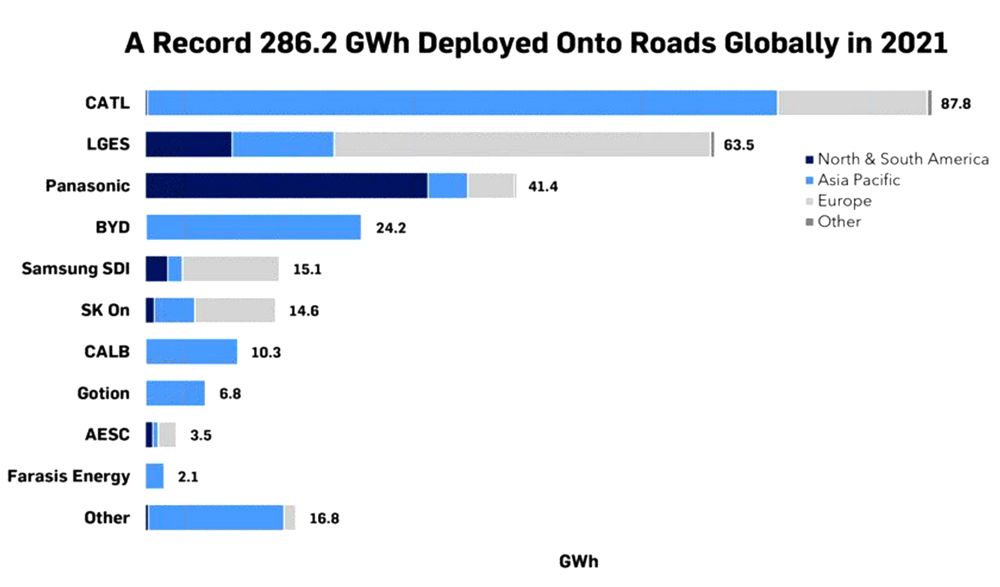
In Alaska, the supply chain delays now plaguing the U.S. energy storage market mean a federally funded microgrid project that was scheduled to come online in August has been delayed for at least a year.
Equipment ordered from Germany didn’t get on the ship to the U.S. as scheduled, said William Thomson, technical and engineering adviser for the Alaska Village Electric Cooperative, which serves 58 communities across the state, many of them only accessible by river or air.
“Our deliveries are made by small plane, and the heavy stuff is always delivered on a seasonal basis by barge,” Thomson said. “The shipping season is from mid-May to early October. If you don’t make that window … you’re stuck; you’re going to have to [go] into next year.”
The cooperative still doesn’t have a delivery date for the storage equipment, he said.
Thomson was speaking at a Clean Energy States Alliance (CESA) webinar on July 14, one of two recent webinars focusing on the U.S. storage market and the challenges it now faces as the speed of technological innovation collides with the drag of supply chain delays and inflation.
Prices are up, investors are becoming more cautious, and building out the domestic supply chain for the lithium-ion batteries needed for transportation electrification could take years. Still, innovation is driving an upside, with the industry working to optimize the efficiency and value of lithium-ion batteries, while also developing long-duration, non-lithium alternatives.
At the Brookhaven National Laboratory in New York, Esther Takeuchi, chair of the lab’s Interdisciplinary Science Department, said her team is working on batteries with a higher energy density, using new materials with a longer life. The result could be EV batteries that can be charged up in 10 minutes, she said.
Speaking at a July 13 webinar on storage innovation hosted by Our Energy Policy (OEP), Takeuchi said another lab priority is “scalable” or big storage, which could be used for grid-scale projects, and “what are the characteristics needed to be big?”
“What are the actual materials?” she said. “How toxic are they? How available? Are they available domestically? Are they only available from a few places on earth, and sometimes those places have their own geopolitical challenges? How do you make things big, functional [and] safe?”
Supply chains will also be a core consideration for big storage, Takeuchi said. At the CESA webinar, both Thomson and Harvey Rambarath, assistant director of planning and development for the Seminole Tribe of Florida, reeled off a string of facts and figures on price increases for key components of solar and storage projects they are developing.
While planning a solar and storage project that would provide power for key tribal community buildings, Rambarath saw price increases of 84.7% for steel pipe and tubes and 44.9% for fabricated structural steel. As a result, he said, project costs increased from the original contract figure of about $2.9 million to over $3.5 million.
Flight to Quality
In other words, said Imre Gyuk, director of energy storage research at the Department of Energy’s Office of Electricity, the U.S. “battery supply chain is not really very robust.”
“The lithium battery industry relies on China, South Korea and Japan,” Gyuk said at the CESA webinar. “Transporting the batteries to the U.S. … adds another 4.1 kg of carbon dioxide to every kWh of battery [capacity].”
The U.S. does have lithium supplies, he said, in geothermal brine at the Salton Sea in California and in hard rock deposits in North Carolina and Nevada. “But mining is extremely capital investment intensive, and you need commitments to get started,” Gyuk said.
The lack of a domestic supply chain, the resulting delays and other market disruptions in the U.S. have sidelined 1.2 GW of new grid-scale storage projects that were scheduled to come online in the first quarter of 2022, according to industry analysts Wood Mackenzie. Still, the industry had a record first quarter, with 955 MW of new projects installed. Grid-scale projects accounted for more than 75% of the total.
Supply chain delays could affect the market — though to a lesser extent — through 2023, Wood Mackenzie said.
Sameer Reddy, managing partner at venture firm Energy Impact Partners (EIP), agrees that supply, not demand, is one of the biggest constraints on the U.S. energy storage market; the other is transmission.
“We just can’t build transmission quickly enough,” Reddy said at the OEP innovation webinar. “As we think about utility-scale solar and wind and attaching storage to that, we can only do that as quickly as we can build out transmission capacity.”
On the financial side of the equation, Reddy sees supply chain disruptions, inflation and threats of a recession driving “a flight to quality” across capital markets, including in the storage sector. “In times like these, the winners get stronger, and the losers get weaker,” he said.
“The infrastructure market for lithium-ion-based projects is incredibly healthy,” Reddy said. Pre-revenue startups developing alternatives to lithium-ion will also be able to secure funding, he said, “as long as they have a very clear story around how they beat lithium-ion technology. … The gap that I am seeing right now in capital markets is all of these new medium- and longer-duration storage technologies.
“It’s really incumbent upon the utilities, in many cases, to pilot those projects and sort of take the initial leap of faith on those technologies to help validate them to the market,” he said.
At the same time, Reddy sees extreme weather events, like the current heat waves in Texas and other parts of the U.S. triggering more “urgency to bring those long-duration technologies on sooner [rather] than later,” The good news, he said, is that several long-duration technologies — gravity-based storage, flow batteries and zinc batteries — are attracting significant investment.
For example, EIP has invested in Form Energy, a Boston-based start-up that is developing 100-hour-duration storage, Reddy said.
“As we electrify different loads across the grid, we’re going to need long-duration sources of storage to really insulate us from a resiliency perspective,” he said.
But Takeuchi stressed that, looking ahead, geography may determine the form of any given storage project. “Whatever form of storage we use, the location where the storage is going to be placed really determines many of the characteristics that are needed,” she said. “Things that are appropriate in wide open areas are not appropriate for areas like New York City or Chicago or [Los Angeles].”
Lifetime performance and costs should also be essential considerations, Takeuchi said. “It’s one thing to set up a system, but then how often do you need to replace it, fix it. If we had very long-life batteries, then things such as second-life batteries become viable.”
The EV Factor
The growing electric vehicle market is another and perhaps even more critical factor in current state of the U.S. energy storage market and supply chains, with exponential growth projected over the next four years, according to Vinayak Walimbe, vice president of emerging technologies at Customized Energy Solutions, an energy management firm.
The global demand for EV batteries stood at 286 GWh at the end of 2021, but is expected increase to 1,100 GWh by 2025, which will require a 40% year-over-year growth in battery production, Walimbe told the CESA supply chain webinar.
 Electric vehicles worldwide put 286 GWh of battery storage on the road last year, but that number could jump to 1,100 GWh by 2025. | Adamas Intelligence
Electric vehicles worldwide put 286 GWh of battery storage on the road last year, but that number could jump to 1,100 GWh by 2025. | Adamas Intelligence
A major increase in raw material costs could be a drag on that kind of accelerated growth, Walimbe said. The industry celebrated when battery cell prices fell beneath $100/kWh in 2021, he said, but steep price increases in lithium and nickel have created a “bullwhip effect,” where small changes in one area of the industry ripple through the supply chain.
Walimbe sees the current supply chain disruptions affecting industries and countries around the world. “They are going to come up with ways to mitigate this.”
For storage, he sees two solutions ― developing a domestic supply chain and recycling — both of which are targeted by funding in the Infrastructure Investment and Jobs Act, he said.
John Rhodes, special assistant to the president in the White House Office of Domestic Climate Policy, agreed that the long-term solution is to bring a lot of mining and manufacturing capacity “on shore, and that’s going to take concerted, broad effort around new solutions” for lithium extraction and creating assured markets.
Rhodes pointed to the “nascent market” for electric vehicle chargers with built-in storage as one such domestic opportunity.
“It’s a self-evident solution to some grid build-out issues that confront a charging station developer,” Rhodes said at the OEP webinar. “Just the emergence of digital solutions around controls and situational awareness and fast response … [is] enabling storage through these enhanced controls to play a better and better role,” which will spur further market growth, he said.



